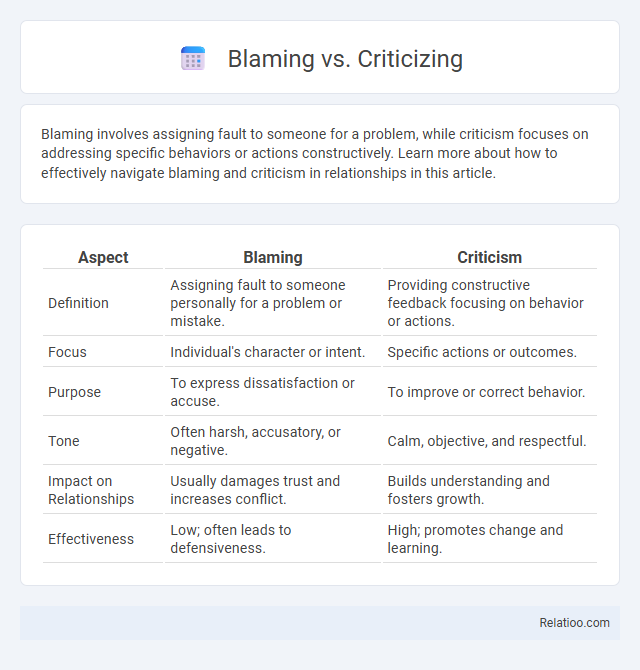Blaming involves assigning fault to someone for a problem, while criticism focuses on addressing specific behaviors or actions constructively. Learn more about how to effectively navigate blaming and criticism in relationships in this article.
Table of Comparison
| Aspect | Blaming | Criticism |
|---|---|---|
| Definition | Assigning fault to someone personally for a problem or mistake. | Providing constructive feedback focusing on behavior or actions. |
| Focus | Individual's character or intent. | Specific actions or outcomes. |
| Purpose | To express dissatisfaction or accuse. | To improve or correct behavior. |
| Tone | Often harsh, accusatory, or negative. | Calm, objective, and respectful. |
| Impact on Relationships | Usually damages trust and increases conflict. | Builds understanding and fosters growth. |
| Effectiveness | Low; often leads to defensiveness. | High; promotes change and learning. |
Understanding Blaming and Criticism
Blaming involves assigning fault to a person or situation for a negative outcome, often leading to defensiveness and conflict. Criticism focuses on evaluating actions or behaviors with the intent to improve or correct, emphasizing specific issues rather than personal attacks. Understanding the difference helps foster constructive communication, where criticism builds growth while blaming hinders resolution and damages relationships.
Key Differences Between Blame and Critique
Blame assigns fault and implies personal attack, often leading to defensiveness and conflict, while critique provides constructive feedback aimed at improvement without targeting the individual. Your ability to differentiate between blame and critique ensures communication remains productive, fostering growth and accountability. Recognizing that blame damages relationships and critique builds solutions is essential for effective interpersonal interactions.
Psychological Impact of Blaming
Blaming creates a negative psychological impact by fostering feelings of guilt, shame, and defensiveness, which can hinder personal growth and damage relationships. Unlike constructive criticism that offers specific feedback for improvement, blaming assigns fault without solutions, often leading to resentment and reduced self-esteem. You can enhance emotional well-being by recognizing the difference and focusing on responsibility rather than fault.
How Criticism Shapes Personal Growth
Criticism, when delivered constructively, serves as a powerful tool for personal growth by highlighting specific behaviors or actions rather than attacking your character. Unlike blaming, which assigns fault and often leads to defensiveness, constructive criticism offers actionable feedback that encourages self-reflection and improvement. Embracing criticism with an open mind enables you to identify areas for development and fosters resilience, ultimately strengthening your skills and relationships.
Blaming in Personal Relationships
Blaming in personal relationships often leads to defensiveness and emotional distance, as it assigns fault instead of addressing the underlying issues. Unlike constructive criticism, blaming centers on assigning responsibility, which can escalate conflicts and erode trust between partners. Effective communication strategies encourage expressing feelings and needs without attributing blame, fostering healthier and more supportive interactions.
Constructive Criticism in the Workplace
Constructive criticism in the workplace fosters growth by focusing on specific behaviors and offering solutions rather than assigning blame or criticizing personally. You can improve team dynamics and productivity by delivering feedback that emphasizes development and learning opportunities. Distinguishing constructive criticism from blaming helps maintain trust and encourages open communication among colleagues.
The Dangers of Habitual Blame
Habitual blame fosters resentment and erodes trust, impeding healthy communication and problem-solving within relationships or teams. Unlike constructive criticism that targets actions and encourages improvement, constant blaming personalizes faults, making you feel defensive rather than motivated to change. Recognizing this distinction helps you break the cycle of negativity and promotes a more positive, solution-focused environment.
Turning Criticism into Positive Change
Turning criticism into positive change involves recognizing the difference between blaming and constructive feedback, where blaming assigns fault without solutions, while criticism can highlight areas for improvement. By focusing on specific behaviors or outcomes rather than personal faults, you can transform criticism into actionable insights that foster growth and development. Embracing a mindset that views criticism as an opportunity rather than a threat empowers your ability to make meaningful progress.
Strategies to Replace Blaming with Critique
Shifting from blaming to critique involves focusing on specific behaviors or outcomes rather than personal faults, which helps maintain constructive communication and encourages problem-solving. You can replace blame with clear, objective feedback by using "I" statements that describe the impact of actions without assigning intent or character judgment. Implementing these strategies promotes accountability and fosters a collaborative environment where challenges are addressed with empathy and actionable solutions.
Building a Culture of Constructive Feedback
Blaming creates a hostile environment by focusing on fault rather than solutions, while criticism often highlights problems without offering actionable guidance, hindering progress. Constructive feedback encourages open communication, emphasizes growth, and fosters a culture where Your team feels supported and motivated to improve. Prioritizing specific, actionable suggestions helps build trust and drives continuous development within any organization.

Infographic: Blaming vs Criticism
 relatioo.com
relatioo.com